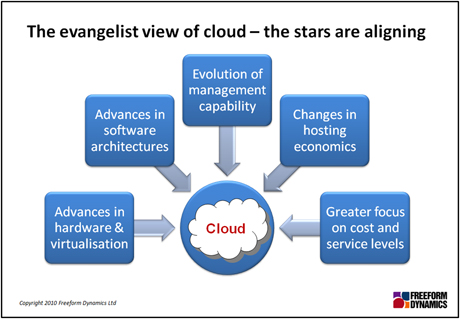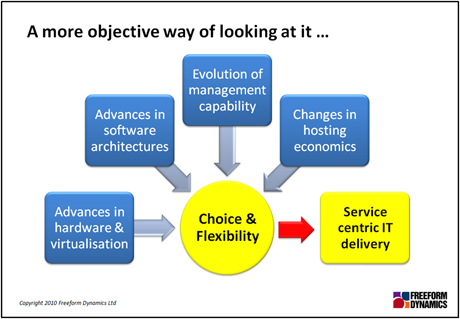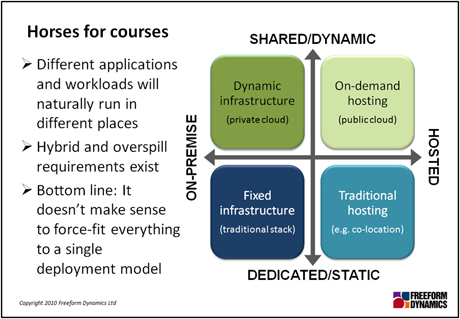Have you ever wondered what we will be left with once the marketing people get bored with the term ’cloud computing’ and move on? It is, after all, inconceivable that this is the last big thing they will ever promote.
A good starting point for analysing what will be left is to decompose the ’stars are aligning’ story often used to argue that cloud is now the centre of everything.
For those who don’t know it, this story starts by drawing our attention to some important industry developments – commoditisation and virtualisation advances in the hardware layer, the evolution of software architectures around componentisation and web services, and the maturing of advanced operations capability in the areas of provisioning, self-service, billing, and so on.
The point is then made that these developments are changing the economics of hosting, allowing providers to deliver services in a cheaper, more robust, and more flexible manner.
Put this together with an increased focus on cost and service level management within the buyer and user community and, so the narrative goes, ’the stars are aligning’.

When you tell the story of IT industry developments over the last decade in this way, it all sounds very reasonable and logical. The analysis can be summed up by the notion that corporate IT will ultimately gravitate towards an elastic hosted services model of IT delivery with a ’utility’ feel to it. Some even argue that corporate datacentres will become a thing of the past.
The snag, though, is all of that pesky legacy, irritating regulation, information management complexity, and a whole range of other practicalities that make ’moving to the cloud’, in the sense of chucking your stuff over the wall and having it running in someone else’s datacentre, is not quite as easy as some would make out. That’s how we end up with the concept of ’private clouds’ and ’hybrid clouds’, where you are taking at least some advantage of flexible computing and so called ’cloudonomics’, but within your own on-premise IT environment.
Whether you regard this as a compromise, a stepping stone or simply the manifestation of the cloud ideal in some other form depends on your perspective. From where we are sitting as a bunch of pragmatic analysts within Freeform Dynamics, however, this whole private/hybrid cloud thing smacks of circular thinking – flexible and efficient technology designed to optimise datacentres has enabled hosted clouds, and if you extract the enabling element from hosted clouds you get, well, flexible and efficient technology that you can use to optimise your datacentre – and thus we end up back where we started. This is basically just an anomaly of marketing.
The trick is to shake the artificial notion of there being something called ’cloud’ at the centre of everything. A much more objective and useful analysis of industry developments can then be made, as illustrated when we tweak the above diagram in the following manner.

Use of the term ’service-centric IT delivery’ on this chart might look like we are just adding to the confusion of language that’s out there, but it’s simply a short-hand way of referring to an approach in which the focus is on what is delivered in terms of capability to business users, rather than how it is delivered.
A really simple example of this is the difference between a service level agreement referring to the email infrastructure (fixed software, servers, storage, etc) versus agreeing with the business that a reliable and performant email service will be maintained. If behind the scenes IT personnel are allocating and reallocating resources on the fly to balance utilisation with performance as email usage fluctuates, then that’s their prerogative. If email capability is moved into the cloud, or hosted resources are used to handle overspill requirements at peak times, then that’s similarly up to IT. All, of course, subject to security, compliance and other constraints, but the point is that it’s the capability provided to the business that matters, and if IT has more choices in how to deliver it efficiently and effectively, everyone benefits.
Looking forward, the latest IT industry developments mean that a variety of deployment models can be considered when looking at how best to fulfil a particular requirement.

Right now, the majority of corporate IT resides in the bottom left hand quadrant, and while cloud evangelists might argue for everything being in the top right, the truth is that if you really focus on how best to deliver capability to business users, you are likely to end up with systems in each of the four quadrants, and even spanning them in many cases.
With this in mind, the real legacy of cloud computing mania will therefore be a more service-centric approach, brought about by the challenging of IT’s historical obsession with technology, and enabled by more choice and flexibility – which wouldn’t be a bad thing at all.